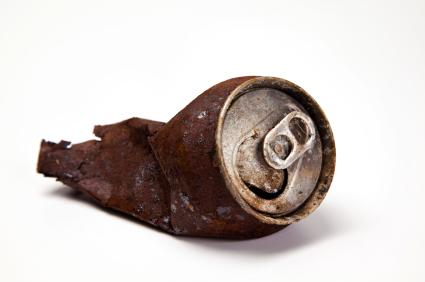| Complexity level: | 7 |
| Project cost ($): | 40 |
| Time required: | 2 hours for preparation, 5 days for observation |
| Material availability: | Easily found |
| Safety concerns: | None |
Hypothesis
Only the aluminum plates that are stored at a sufficiently high temperature will corrode.
Overview
Corrosion in aluminum
Aluminum is the most abundant metal found on Earth and has excellent resistance to corrosion. This strong resistance to corrosion is due to the layer of oxide on the metal’s surface. Should the coating be damaged, it will immediately reform on the surface. This process will occur is most environments.
The oxide film that forms on the surface of aluminum is normally stable in solutions with pH values between 4.0 and 8.5. The conditions required for the corrosion of aluminum are that the oxide film must undergo continual abrasion or that the protective coating is damaged while being deprived of the oxygen supply required to rebuild the coating.
Increasing the temperature while the humidity of the environment remains constant will also increase the rate of corrosion. A higher temperature will stimulate the corrosion process by increasing the speed of the diffusion process as well as the electrochemical reactions taking place.
Scientific Terms
Materials
The materials required for the science fair project:
- 5 pieces of aluminum plate, each measuring 5centimeters x 5centimeters
- 5 beakers
- 2500 milliliters of tap water
- 50 grams of salt
- 100 grams of ferric chloride
- 5 beakers
- 4 hotplates
- 1 measuring cylinder
- 1 digital weighing scale
- 1 bottle of vegetable oil
- 5 thermometers
- 1 spatula
Procedure
1. For this science fair project, the independent variable is the storage temperature of the aluminum plate immersed in the salt solution. The dependent variable is the formation of rust on the surface of the aluminum plate. This is determined by observing the aluminum plate after a period of 5 days. The constants (control variables) are the concentration of salts in the solution, the types of salt used, amount of water in the beaker and the size of the aluminum plate.
2. Using the measuring cylinder, measure and pour 500ml of water into each of the 5 beakers. Weigh 10g of salt and 20g of ferric chloride and add them to each of the 5 beakers. Mix the solutions with a spatula.
3. Place 1 aluminum plate inside each of the 5 beakers. Then, pour about 3-5mm of vegetable oil over the solution in each beaker. Place 1 thermometer inside each beaker.
4. Store the first beaker at room temperature (25 °C) for the next 5 days. Place the remaining 4 beakers on hotplates, and adjust the temperature of each to 40 °C, 55 °C, 70 °C and 85 °C. Check the thermometers and hotplates periodically to ensure that the temperatures remain constant.
5. After a period of 5 days, inspect the aluminum plates for markings of rust or corrosion. Record your observations in a table, as shown below.
Results
It was observed that the aluminum plate will start to corrode at temperatures above 70 °C.
| Temperature | 25 °C | 40 °C | 55 °C | 70 °C | 85 °C |
| Corrosion | X | X | X | Y | Y |
X – No corrosion is observed, Y - corrosion is found on the surface
Conclusion
The hypothesis that only the aluminum plates that were stored at a sufficiently high temperature will corrode, has been proven to be true.
Aluminum has very good corrosion resistance, and its electrical conductivity and thermal properties make it really easy to work with. The recent increase in global copper prices has increased the demand for aluminum to be used in wire and cables.
Also consider
Will the results differ if this science fair project were to be repeated by immersing the aluminum plate in water, salt water and acid at high temperatures?
You could also try placing the aluminum plates in solutions of different pH levels.
References
Aluminum corrosion - http://corrosion-doctors.org/MatSelect/corralumin.htm
Cast Nonferrous: Corrosion of Aluminum and Aluminum Alloys -http://www.keytometals.com/Article14.htm
Temperature - http://www.corrosionsource.com/technicallibrary/corrdoctors/Modules/Aircraft/tempera.htm

